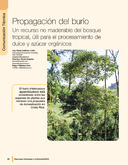Mostrar el registro sencillo del ítem
Propagación del burío: un recurso no maderable del bosque tropical, útil para el procesamiento de dulce y azúcar orgánicos
| dc.contributor.author | Gutiérrez Uribe, A.M. | |
| dc.contributor.author | Mesén Sequeira, F. | |
| dc.contributor.author | Villalobos Soto, R. | |
| dc.date.accessioned | 2020-10-26T20:39:59Z | |
| dc.date.available | 2020-10-26T20:39:59Z | |
| dc.date.issued | 2004-03 | |
| dc.identifier | es | es_ES |
| dc.identifier.issn | e-ISSN: 1021-0164 | ISSN |
| dc.identifier.uri | https://repositorio.catie.ac.cr/handle/11554/9781 | |
| dc.description | 8 páginas, 6 ilusciones, 1 tabulaciones, 26 referencias. | |
| dc.description.abstract | En este trabajo se evaluó la propagación del burío por semillas, estacas y acodos. Se encontraron diferencias en la germinación de semillas de las fuentes identificadas de Santiago de Paraíso (1450 msnm), CATIE (600 msnm), Platanillo o Tayutic (1100 msnm) y Matina (50 msnm). El material de Santiago de Paraíso produjo la mejor germinación (62,3 porciento para semillas extraídas y 50,3 porciento para semillas dentro del fruto). La regeneración natural parece la mejor alternativa para asegurar el uso sostenible del burío, el cual produce más de medio millón de semillas por árbol. Para las estacas, en propagadores de sub-irrigación, el mejor porcentaje de enraizamiento (33 porciento) se obtuvo en arena y con 0,3 porciento (P/V) de ácido indol-3-butírico (AIB) disuelto en metanol puro aplicado a la base de la estaca, bajo polietileno transparente y sombreado hasta lograr una radiación fotosintéticamente activa (RAFA) de 78 moles/m 2 /seg, en promedio. Para los acodos, el musgo y el aserrín fueron los mejores sustratos para el enraizamiento (53 porciento) Y producción de raíces. Sin embargo, se debe investigar más esta alternativa de propagación, ya que ningún acodo sobrevivió al transplante en bolsas. | |
| dc.description.abstract | In this work we assessed the burío propagation by seed, cutting and air layering. Differences were found in the germination of seeds from four identified sources: Santiago de Paraíso (1450 masl), CATIE (600 masl), Platanillo or Tayutic (1100 masl) and Matina (50 masl). Santiago de Paraíso seeds showed the best results at nursery (62,3 percent for clean seeds and 50,3percent for seeds inside the fruits). Natural regeneration seems to be the best alternative for ensuring a sustainable use of burío, which can produce more than half a million seeds per tree. The best rooting percentage for cuttings in non-mist propagators (33 percent) was obtained in sand with 0,3 percent (W/V) of indol-3-butiric acid (IBA) dissolved in pure methanol applied to the cutting base, under clear polyethylene and shaded to obtain a mean photosynthetic active radiation (PAR) of 78 mol/m 2 /seg. In air layering, moss and sawdust were the best substrates for rooting (53 percent) and root production. Nevertheless, additional research is required, since none of the air layerings survived after planting in bags. | |
| dc.publisher | CATIE, Turrialba (Costa Rica) | |
| dc.relation.ispartof | Recursos Naturales y Ambiente Número 41 (Marzo 2004), páginas 80-87 | |
| dc.rights | info:eu-repo/semantics/openAccess | |
| dc.subject | ARBOLES FORESTALES | |
| dc.subject | PROPAGACION DE PLANTAS | |
| dc.subject | SEMILLA | |
| dc.subject | PREGERMINACION | |
| dc.subject | GERMINACION | |
| dc.subject | PODER GERMINATIVO | |
| dc.subject | ACODO | |
| dc.subject | ESQUEJES | |
| dc.subject | ENRAIZAMIENTO | |
| dc.subject | PRODUCTOS FORESTALES NO LENOSOS | |
| dc.subject | PROPAGACION VEGETATIVA | es_ES |
| dc.subject | EDULCORANTES | es_ES |
| dc.title | Propagación del burío: un recurso no maderable del bosque tropical, útil para el procesamiento de dulce y azúcar orgánicos | es_ES |
| dc.title.alternative | Propagation of burio. A non-timber resource from the tropical forest, useful for the processing of organic non-centrifugal and refined sugar cane. | |
| dc.type | Artículo | es_ES |


